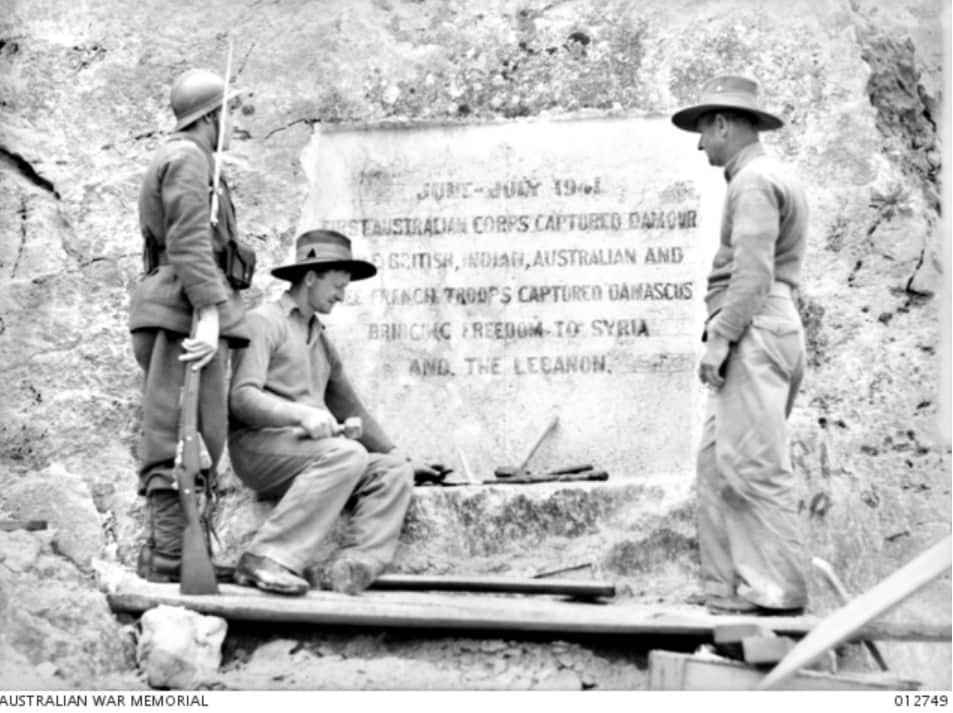During the preceding months, the Australian 7th Division marched towards Lebanon on two fronts, while other Allied forces headed towards Syria from Palestine.
Syrian border. Group photo of members of the 2/6th Australian field company, Sergeant Raymond Alexander OGG is first on the left in the front row. Source: Australian War Memorial
The Australians faced fierce resistance during their advance near the Litani River, Jezzine, Merjeoun and Damour.
Dr Ali Yousuf Hijazi is from the village of Debbin in southern Lebanon and is the author of ‘Kashkoul Debbin’, a book detailing the history of the region and personal accounts of those who lived through it.

An inscription cut into a cliff to record the capture of Damour by the Australians. Source: Australian War Memorial
He told SBS Arabic24 that the battles fought by the Australian forces were pivotal to the overall result of the war.
Just days after a truce was called in 1941, Australian soldiers, accompanied by other Allied forces, entered Beirut and remained for the duration of the war.
Commemorated in the modern day
More than eight decades after the campaign, Lebanon continues to embrace the monuments that testify to the presence of Australian forces on its soil, and perhaps the most important of these is the railway line between Beirut and Tripoli, which is in a state of disrepair.

Graves of Commonwealth soldiers at the Beirut War Cemetery, 25 April 2018. Source: Photo provided by the Australian Embassy, Beirut
Many of the crumbling bridges and pillars that make up the line still bear the emblem of the Australian Imperial Forces and the engineering units that oversaw its construction.
For Ms Grindlay, the finest Australian achievement in terms of construction was the construction of the bridge over Dog River, 20 kilometres north of Beirut.

The bridge over Dog River. Source: Australian War Memorial
‘They had no exploitative motives’
He explained that in 1941, Australian forces employed local villagers to dig trenches to prevent Axis forces from advancing.

Dr Ali Yousuf Hijazi standing alongside what remains of a structure he believes was built by Australian soldiers. Source: SBS Arabic24 (Iman Riman)
“The Australians paid a generous amount of money; the villagers left their work in the farms and went to help the Australians.
“They were poor, and the amount of money paid in an hour would be equivalent to a full day wage.”

Part of a WWII hospital structure Dr Hijazi believes was built by Australian forces. Source: SBS Arabic24 (Iman Riman)

Part of an entrance to a WWII hospital Dr Hijazi believes was built by Australian forces. Source: SBS Arabic24 (Iman Riman)
Dr Hijazi believes that Australians built a military airport and an underground hospital in the far south of the country, though he confirms that there is no official record to prove they were solely responsible.
“The airport was deserted as soon as the war ended and was never used after, but there were plans to transform the hospital which still remains in a good condition, into a military museum, but that did not happen, unfortunately.

Trenches built by Australian soldiers in Southern Lebanon during WWII. Source: SBS Arabic24 (Iman Riman)

Dr Hijazi stands at what he believes was once the site of an Australian-built airport in Southern Lebanon. Source: SBS Arabic24 (Iman Riman)
“There is no doubt that the Australians have left a strong impression and fond memories with the Lebanese people.
“We must say how grateful we are to the Australians, while others killed the men and abused the women, the Australians left not only great monuments but also great memories.”

The WWII shrine in the village of Debbin. Source: SBS Arabic24 (Iman Riman)
Source Agencies


